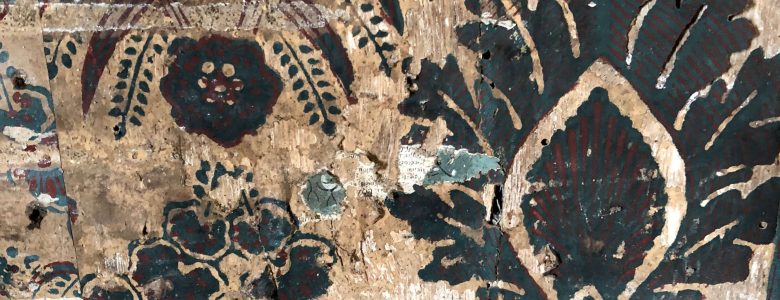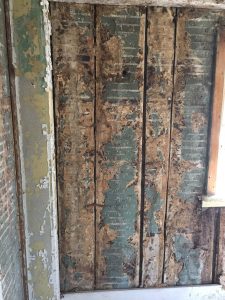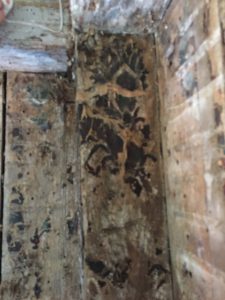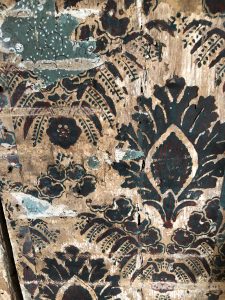November 13, 2017
The Mystery Behind the Early Wallpaper in the Sitting Room: Part 2

An extraordinary room revealed
This unremarkable sitting room turned out to be a rare example of early decorative wall coverings that no one could have expected or even imagined. In fact, we were astounded by what we found underneath the 20th century features and materials predominating the room. The Akin House surprised us yet again!
- The left side shows the oak corner post covered with trim (not original but presumed to be ca. 19th century) and part of the wall after the plaster and lath were removed.
- Another corner post and adjoining walls reveals early decorative features.
- Detail of a corner post.
- In another section of the room, we see another example of the palmette style, better preserved on an interior wall.
- Another closeup of the wall covering on an interior wall.
- Close-up of the palmette or palmetto style, darkened over the centuries.
What’s the mystery?
The early decorative wall coverings came to light in August 2017. No one knows for certain when the original wallpapers were last seen. It appears that when the owners made changes to this little house, they just kept adding and covering. The first reveal of this room as it might have been in the late 18th century was nothing short of impressive. The ghosts of this house had reappeared in the guise of the decorative arts of that time.
We consulted with Historic New England (HNE) to determine if similar wallpapers were to be found in their collections.
HNE’s Sally Zimmerman suggested that I speak with the folks at the Center of Painted Wall Preservation. https://www.pwpcenter.org
Although the Center specializes in historic painted walls such as murals and stencils, and not wallpaper, Director Linda Lefko was intrigued by our findings and agreed to embark on the research. She contacted the Center’s experts in the hope that someone might be familiar with this type of wall decoration.
Mystery Solved!
Following consultations with members of the Center’s advisory panel, this is what they learned. Arsenic was a significant clue.
In Lucinda Hawksley’s book Bitten by Witch Fever–Wallpaper & Arsenic in the Victorian Home, published in 2016 by Thames & Hudson, Ltd., London, she writes “In late eighteenth century England, the physician Thomas Fowler concocted a solution of 1 per cent potassium arsenic (‘liquor mineralis’) for the treatment of fevers and headaches.” She notes that Carl Wilhelm Scheele, a Swedish/German chemist introduced arsenic to green pigment to create what became known as Scheele’s green. She goes on to write “It is understandable that the use of white arsenic pigments, beginning with Scheele’s green in 1775, was not immediately perceived as a health hazard.”
By the late 18th century, wallpaper manufacturers soon added arsenic to create the bright colors embraced by the public. By the late 19th century, its toxicity could no longer be ignored, regardless of William Morris’s protestations to the contrary.
While the Center for Painted Wall Preservation didn’t actually date our wallpaper, the arsenic in the wallpaper explains the unusual effect of the design, some of it left intact even after about 250 years. Insects were repelled by arsenic. It is not farfetched to suggest that the wallpaper in our sitting room is very early. Did anyone fall ill or die because of this toxic decor, we may never know.
The Center’s report (below) solves the mystery and shows an example of this phenomenon by a fellow conservator in a 1830 house in Topsham, Maine. Richard Nylander, retired senior curator of HNE and a wallpaper specialist also noted “The block foliate pattern, probably of the 1840s, is typical of wallpaper designs of the 1845-1860 period.”, also pictured in the Center’s report.
Please read on:
We thank HNE and the Center for Painted Wall Preservation without whose help, this mystery might yet to be solved.







What’s up,I log on to your new stuff named “The Mystery Behind the Early Wallpaper in the Sitting Room: Part 2 – Dartmouth Heritage Preservation Trust” like every week.Your story-telling style is awesome, keep up the good work! And you can look our website about free proxy.
You may have seen the blog about the conservation work by a team of experts to analyze, clean and stabilize the wallpaper in the sitting room. I am awaiting their final report before I post another blog about that early wallpaper. Thank you for keeping track of DHPT’s activities. I have been very busy of late and haven’t posted any new blogs since February. I hope you saw that Maureen Taylor, the nationally recognized and well-known “The History Detective” to do a lecture about her research on the photographs which are featured in her two volumes, “The Last Muster.” She is working on a third volume. check out her website.